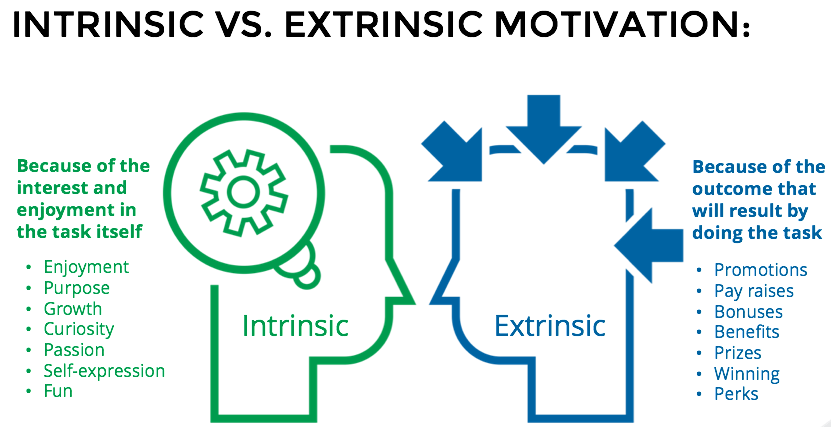What gets you out of bed in the morning?
What is intrinsic and extrinsic motivation? For some people, it’s the thought of a hot cup of coffee. Maybe it’s the pressure of making it to work before traffic. For some, it’s seeing the smile on their child’s beautiful face. Whatever makes you get out of bed in the morning motivates you. We all have reasons for doing the things we do– in our personal and professional lives, and it turns out that some of those reasons just make more sense than others.
Motivation is what allows us to see the light at the end of the tunnel after a horrible day at work. It is why many people take the courageous leap of faith to change careers in their 40’s. It is why we spend nearly one-third of our lives on the job.
So what are we even working for?
What motivates people in their career has been studied thoroughly in the field of organisational behaviour. For the most part, it can be narrowed down into two categories: intrinsic and extrinsic motivation.

What is intrinsic motivation?
Intrinsic motivation comes from your own internal desire to grow. When something has meaning in your life, it is seldom seen as work, or perhaps, work that you enjoy. Intrinsic motivators tend to be more psychological and connected with personal satisfaction rather than tangible rewards.
One significant motivator that can change a person’s outlook on their career is autonomy. This is the feeling that you may get when you feel responsible and in control of your career. Studies show that autonomy is essential in overcoming challenges, performing to one’s best, and seeking out new curiosities. This is not to say that it is a reward that you strive for by performing well, and your boss gives you more independence and responsibility in return. It is that having independence and responsibility for their career are what drive people to perform well in the first place.
Other intrinsic motivators include purpose and belonging. Purpose is how we know that our work has meaning in the world. It is how we see the contributions of our careers as fulfilling. Belonging is the feeling that we get when we are a part of something. It is more motivating to work with people who accept you and include you and appreciate your contributions.
What motivates you may be very different from your peers. Some people are motivated because they want to learn simply out of curiosity. Some people feel they’ve done their best by being a part of the decision making process with upper-level management. Maybe you just want to work on your own, but you want your boss to notice and appreciate your effort.
These are realistic, meaningful, and relevant rewards that empower us to do our best.
What is extrinsic motivation?
Extrinsic motivation comes from external factors, such as a raise or a promotion. It uses “carrots”- positive reinforcement, and “sticks”- negative punishment to draw out a certain behaviour.
If you want your sales team to increase sales by 15% in the next period, you might offer the leading salesperson a bonus to motivate everyone to work harder. On the contrary, if you have an employee who was written up numerous times, the threat of being fired might encourage him or her to improve performance.
Extrinsic motivation is sufficient for manual tasks or lower-level employees because these jobs are often based on tact and production instead of cognition.

What Is the Difference Between Intrinsic and Extrinsic Motivation?
In contrast to intrinsic motivations that stem from inner desires Extrinsic motivations are derived through external incentives. Both motivate workers to finish their jobs or duties, but extrinsic rewards are able to be used to create intrinsic motivations. However, it’s not likely to happen the reverse way.
What’s the difference?
To understand the difference between intrinsic and extrinsic motivation, here are a few comparative examples:
Intrinsic motivation:
- “I am participating in a work conference because I want to learn about my industry.”
- “I want to lose weight to improve my confidence.”
- “I am learning a new language to connect with others.”
- “I want to lead a successful project to inspire other young leaders.”
Extrinsic motivation:
- “I am participating in a work conference because it looks great on my resume.”
- “I want to lose weight to win a weight-loss competition.”
- “I am learning a new language for an exam.”
- “I want to lead a successful project for a bonus.”
Whereas extrinsic motivation has an external reward, the “reward” sought out through intrinsic motivation comes from inside.
Is extrinsic motivation enough?
External factors such as rewards are a great way to achieve temporary performance measures. We live in a “do this, get that” world, and extrinsic motivation can get us to meet small goals over time.
While extrinsic motivation encourages us to do what we have to do in pursuit of a reward, it does not make us find meaning and enjoyment in the task. For this reason, it is easy to see why someone who earns an excellent salary may not be fully satisfied in his or her job.

Studies have shown that oftentimes, the things that motivate employees to feel the most fulfilled in their careers have little to do with money and materials. Moreover, intrinsic motivators improve performance over time.
- Intrinsic motivation is strongly related to creativity. Serotonin and dopamine, the neurotransmitters that are responsible for happiness, are also associated with creativity, memory, and improved cognitive functioning.
- Extrinsic motivation is not sustainable. Rewards and punishments do not change someone’s overall attitude and values; they only change temporary behaviours.
- The “overjustification effect” states that offering incentives for a task that somebody already enjoys will decrease their motivation. This is because of our associations between external rewards and mandatory obligations.
- Doing work that is perceived as meaningful leads to loyalty to the organisation and higher levels of productivity.
- Employees who feel that they belong at their organisation have higher job performance, lower turnover, and use less sick days.
How can you use this in your life?
If you are having trouble motivating an employee to meet deadlines and work on a team, ask yourself “what is he or she working for?” Goals and performance profiling are great tools to elicit tangible results, but will that change his or her overall attitude? These results should be valuable and meaningful so that we can look at our jobs with satisfaction.
If you have an employee that seems to be unmotivated, figure out his or her needs. Some people work best alone, and leading a team would not be desirable. Their best might come from the ability to work independently from home. Some people are born to lead, and doing mundane tasks under close supervision is discouraging. In this case, it would probably be meaningful to offer them the lead in a project or provide input for a big decision with their boss.

Either way, a performance coach can be a useful resource in identifying employee needs.
In the end, understanding the types of motivation can help us change our attitudes on work, learning, and life. It is shown that a person’s motivation has a lot to do with the meaning behind their work, so we must understand that what is valuable is decided by the individual. A task that pertains to someone’s values is a task that will be done well.











